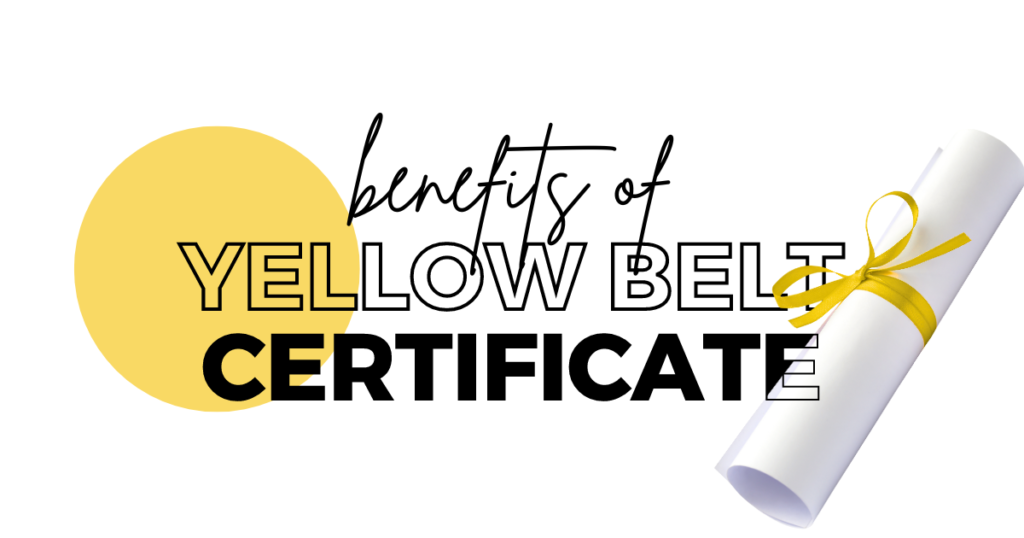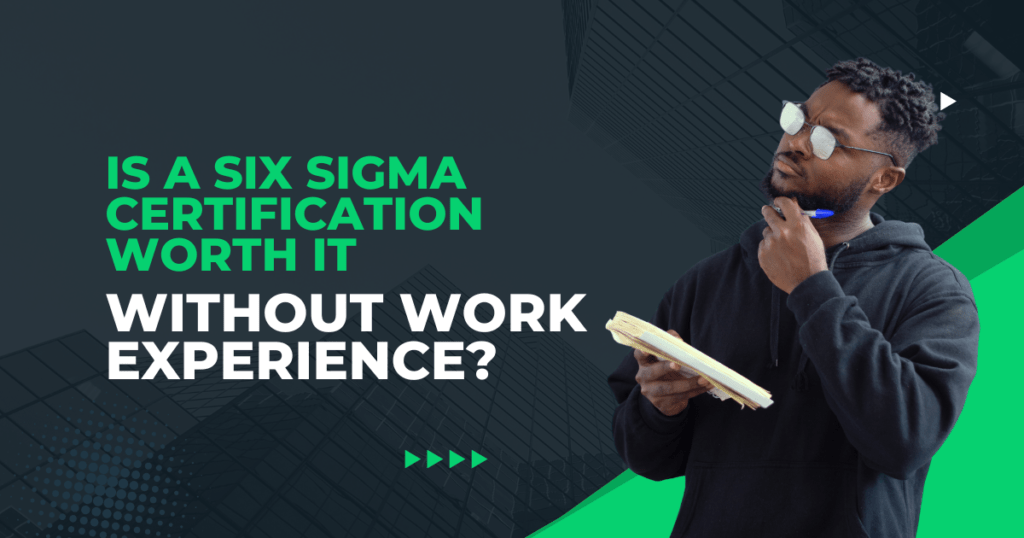Table of Contents
When it comes to Lean Six Sigma, you will quickly identify there are a number of “belts” associated with the approach. From White Belt, through to Yellow, Green and Back Belt, right up to Master Black Belt, there are a number of stages you need to progress through. These stages, levels or belts are all dependent on your experience thus far, what you are hoping to achieve out of getting the qualification and your role within the business.
Understanding what belt is right for you can sometimes be tricky, and the advice on this is patchy. For some highly experienced, statistically-minded Project Managers, they won’t need to go through all of the belts and can start at a higher level. For a Junior, dipping their toe into the world of Lean, Six Sigma, Quality and Business Improvement, they may need to work through them all to give them the knowledge, experience and confidence to progress further.
Wherever you are at, we have provided in this article a handy guide to each of the belts to show you:
- What you need to be bringing to the table – this mainly revolves around experience so far.
- What you get from Each Six Sigma belt – this will cover the fundamentals of what the course will provide to you.
- Features of the training – so we will look at some of the basics around duration, exam requirements and outcomes.
This guide will steer you in the right direction when it comes to making a decision about which belt to take, and it is a guide I wish I had had back when I started out on my Lean Six Sigma journey! Let’s begin.
Six Sigma White Belt

The White Belt is known as the introductory belt. This is a belt that is often overlooked and sometimes ignored by those starting out on this journey. The belt is very much focused on introducing you to the key topics and terms that exist within the Lean Six Sigma world, so if you already have knowledge of that, you can probably skip over this belt.
| What you need | RAG | What you get |
| Basic understanding | ❌ | Introduction to the topic |
| Statistical knowledge | ❌ | 7 basic tools of quality |
| Project leadership | ❌ | Breakdown of Lean & Six Sigma |
| Experienced professional | ❌ | Breakdown of value vs. non-value add |
| Experience of LSS project work | ❌ | Basic understanding of quality |
| Features of the training | Information |
| Duration | 2 hours |
| Desired format | Online |
| Course interactivity | None – listen and learn format |
| Project needed to certify? | No |
| Exam needed to certify? | Yes |
| Responsibilities | None |
| Outcome for you | Knowledge of the topic |
| Relationship to others | Support their activities |
Join our Six Sigma White Belt Certification Program
Six Sigma Yellow Belt

The Yellow Belt is when you start getting into the key workings of Lean Six Sigma. It will split out the two concepts of Lean and Six Sigma, walk you through a typical project deployed via this belt and show you the key stages and deliverables required.
This course is typically deployed over a 2 – 3 day period or, if you’re self-teaching online, can be done in around 10 hours. Please note, if you come across Yellow Belt courses offering you a certification and it is under 6 hours, avoid!
| What you need | RAG | What you get |
| Basic understanding | ✅ | How to support a LSS project |
| Statistical knowledge | ❌ | Supporting DMAIC (Define, Measure, Analyze, Improvement, Control) methodology |
| Project leadership | ❌ | Root cause analysis tools (Fishbone, 5 Whys) |
| Experienced professional | ❌ | Process mapping tools (Flowcharts, SIPOC) |
| Experience of LSS project work | ❌ | Basic data analysis |
| Features of the training | Information |
| Duration | 16 hours |
| Desired format | Evidence of the deployment of some of the tools and techniques learned in the course, plus supporting on wider Lean Six Sigma-related projects |
| Course interactivity | Practice a handful of the tools |
| Project needed to certify? | No |
| Exam needed to certify? | Yes |
| Responsibilities | You can support related projects |
| Outcome for you | You can support on related projects |
| Relationship to others | Support their activities |
Join our Six Sigma Yellow Belt Certification Program
Six Sigma Green Belt

At the Green Belt level, we build on what we have learned in the Yellow Belt, but this time add in a lot more on the data front. This includes data creation, data analysis and data analytics. We also introduce the statistical software tool that is Minitab, and use more statistical tools to understand our data to make more informed decisions.
It is advised that at this belt, the training is done in person and LIVE (whether physically in a classroom or through a virtual classroom). This is because the Green Belt also steps up the interactivity, so working with others when doing this helps you to grasp key concepts better and, if you get stuck on any of the data work, you have an experienced professional on hand to assist.
| What you need | RAG | What you get |
| Basic understanding | ✅ | How to run a LSS project |
| Statistical knowledge | ❌ | Delivering DMAIC (Define, Measure, Analyze, Improvement, Control) methodology |
| Project leadership | ❌ | Intermediate statistical analysis software (such as MiniTab) |
| Experienced professional | ✅ | Intermediate statistical software tools (such as Time Series, Control Charts) |
| Experience of LSS project work | ✅ | Intermediate data analytical skills |
| Features of the training | Information |
| Duration | 30 hours |
| Desired format | Evidence of the deployment of some of the tools and techniques learned in the course, plus supporting on wider Lean Six Sigma-related projects |
| Course interactivity | Plan out a whole project and practice deployment of tools, techniques and datasets |
| Project needed to certify? | Yes |
| Exam needed to certify? | Yes |
| Responsibilities | You can support and lead on Lean Six Sigma projects, partially or end-to-end |
| Outcome for you | You can support and lead on Lean Six Sigma projects, partially or end to end |
| Relationship to others | Manage Yellow Belts, support Black Belts |
Six Sigma Black Belt

The Black Belt level takes a lot of what was learned at the Green Belt level but steps it up from an intermediate grade to an advanced one. The focus is still very much on data, statistics and analysis, but with an increased focus on full end-to-end delivery of Lean Six Sigma projects as part of a wider program of work.
A this level you will also need to be more considerate of your role as a leader in this field within your business, and the duty of care you now have to Green and Yellow Belts. Given the increased complexity of this training and the need to learn practically, with good exercises, examples and demonstrations, it is recommended that this training be in person (virtually or physically). Online pre-recorded courses will give you the concepts but if you get stuck along the way (and many of us do when we are learning this topic) you have nowhere to go, and that can get frustrating!
| What you need | RAG | What you get |
| Basic understanding | ✅ | How to run a LSS project or program |
| Statistical knowledge | ✅ | Delivering DMAIC (Define, Measure, Analyze, Improvement, Control) methodology |
| Project leadership | ✅ | Advanced statistical analysis software (such as the full spectrum of MiniTab) |
| Experienced professional | ✅ | Experience in LSS project work |
| Experience of LSS project work | ✅ | Advanced data analytical skills |
| Features of the training | Information |
| Duration | 50 hours |
| Desired format | Evidence of the deployment of some of the tools and techniques learned in the course, plus supporting on wider Lean Six Sigma-related projects |
| Course interactivity | Plan, designed and deliver a full end-to-end Lean Six Sigma project, utilizing the full range of data analytics and analysis tools available through Minitab |
| Project needed to certify? | Yes |
| Exam needed to certify? | Yes |
| Responsibilities | You can support and lead on Lean Six Sigma projects, partially or end-to-end |
| Outcome for you | You can support and lead on Lean Six Sigma projects, partially or end to end |
| Relationship to others | Manage Yellow and Green Belts, frequently engage with project sponsors and champions |
Six Sigma Master Black Belt

At this level, you take a step away from the formal Lean Six Sigma framework. It is now assumed that you have delivered many Lean Six Sigma projects, have managed and supported Yellow and Green Belts and are at the program level. This approach focuses more on strategy, program and decision-making, building out a framework and structure for the success of Lean Six Sigma delivery.
This level of certification requires a lot of time and effort, including delivering what is taught along the way. This should ideally be trained in person, with online courses offering this level of knowledge and experience being largely useless. With this level, you need to deploy, you need to feel, experience, communicate, deliver, delegate etc. That cannot be done through an online pre-recorded course. (Indeed, if someone claims to be a Master Black Belt after doing an online course, many will discount this qualification as invalid as it hasn’t gone through any of the required steps to learn and officially certify).
| What you need | RAG | What you get |
| Advanced understanding | ✅ | Lead on design for Six Sigma |
| Advanced Statistical knowledge | ✅ | Managing & Influencing stakeholders |
| Project & program leadership | ✅ | Coaching Masterclass |
| Experienced professional (10+ years) in related settings | ✅ | Advanced Lean techniques and advanced voice of the customer knowledge |
| Led several LSS projects (20+) | ✅ | Organizational transformation |
| Experience of program directorship and management | ✅ | Advanced statistical techniques, strategy cascade and 7MP tools |
| Features of the training | Information |
| Duration | 100 hours + (with a sizeable duration for the full program, sometimes 1 – 3 years) |
| Desired format | In person |
| Course interactivity | A significant amount of practical design and delivery alongside theory. Practicing coaching, statistics using extensive datasets, customer journey mapping and analysis datasets etc. |
| Project needed to certify? | Yes |
| Exam needed to certify? | Yes |
| Responsibilities | Deploy what is being learned practically in the working environment as you move through the modules. Modules are spaced out to ensure practical delivery can be applied |
| Outcome for you | You design the program and the wider strategy for the business, identifying who needs to be where, what the outcomes need to be, advising others on good strategic decision making etc. |
| Relationship to others | Manage full teams of Lean Six Sigma Belts (all belts), advise Black Belts on their projects, give structure and clarity around the approach |
Conclusion
As you can see, there is a LOT to learn, a LOT to cover and a LOT of stages to move through when it comes to Lean Six Sigma. Let’s close on some key takeaways and advice:
- The higher up the belts you go, the more imperative it is to have in-person training. Whether physically or digitally, classroom-based training offers a lot more for Green, Black and Master Black Belts. These courses are much more interactive and group exercises will help you to grasp how to practically deploy what you learn.
- You don’t have to do all of the belts. If you want an understanding of how to support and deploy, you can complete the White and Yellow Belts and no more. If you are an experienced professional, you could do the Yellow and Black Belts only, getting what you need from each of those.
- Really think through what you need from this qualification, and why. Don’t just get the qualification and never use it. Understand what you need it for – to save money, to reduce waste, to improve quality, to improve stability and capability, to improve customer experience etc.
- Practice makes perfect! When you certify (or during the process of learning) use what you learn as much as you can. On so many occasions people get one belt, then move on to the next, and the next, and never actually stop to deploy what they have learned. Lean Six Sigma is best learned through the doing. If you go to an interview and say you are qualified in Lean Six Sigma, they will ask for practical examples of what projects you have deployed, how you deployed them and the outcomes/benefits for the business. If you say you only have the qualifications but no experience, they have no value to a future employer.
- Embed into your daily activities. Whether it is using process mapping tools, facilitating brainstorming sessions or making decisions based on extensive data analysis, use what you have learned as much as you can. This can be outside of projects and programs. For example, if something goes wrong in your daily activities, pull on the Fishbone Diagram to identify potential causes, categorize them and find a solution.
Remember. To get the most out of Lean Six Sigma – learn, practice, deploy!











